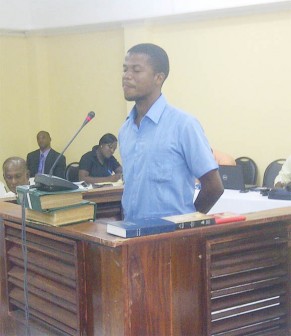– witness tells inquiry
The weapons used by the riot unit that was deployed to Linden on July 18 were not returned to the armoury until three days after the unit got back from Linden and four policemen had less ammunition than they had taken, but no explanation was given, a police witness testified yesterday.
Corporal Donald Harry, whose main duty is to issue and receive firearms and ammunition, told the Commission of Inquiry into the Linden protestor shootings that it was on July 22 that the 14 Tactical Services Unit (TSU) ranks returned the weapons they had carried to Linden.
Attorney Nigel Hughes, who is representing the interest of the families of the three men killed on July 18, asked whether any rank returned with less than what they had taken, Harry explained that Sergeant Junior left with 10 12-gauge cartridges and returned with seven, Constable Parker left with 10 12-gauge cartridges and returned with nine, Constable McBean left with 10 CS grenades and returned with six and Constable George left with 10 CS Grenades and returned with five.

According to Harry, Assistant Superintendent of Police Patrick Todd, who led the squad, was informed of this but no explanation was given for the irregularities.
Harry also noted that the weapons were returned three days after the ranks would have returned from Linden.
Attorney James Bond, one of the lawyers for APNU, asked whether it is customary that the arms be immediately lodged upon return and Harry responded in the affirmative. He asked whether the delay between the return of the ranks and the lodging of the weapons was unusual and Harry admitted that it was.
Bond further asked if ranks are allowed to use weapons assigned to other ranks and was again answered positively. However, Harry explained that a record must be kept of this in the station diary.
Todd had told the inquiry that he was the only person to fire shotgun cartridges and discharge teargas, after objects were thrown at the unit and explosions had been heard. Todd also said he had not seen any of the ranks fire. At 11 pm on July 18, after the protestors were shot, Todd and his team were relieved of their duties.
Also testifying yesterday was Police Constable Maxwell Grant, who said that he photographed and made videos of the events in Linden on July 18. According to him, he was instructed to travel to Linden with a TSU unit and on arrival around 22:00 hrs he noticed a fire at the Kara Kara Bridge, which was also blocked. He pointed out that he filmed and took photos of this scene. Further up, he continued, the Linmine building was also seen on fire and this also was videoed and photographed. The witness pointed out that this was some time after 23:00 hrs.
“There was something like a trailer. I don’t know what it was but it was across the road in the same Linmine area,” Grant said, adding that he photographed and videoed this too. He and the ranks, he explained, drove for some time to see if there were any more blockages before going to the Mackenzie Police Station.
The following day, Grant said, tyres were being burnt on the roadway at Silver Town. At the Mackenzie-Wismar Bridge, he said, there were sand bags and a log laid across, preventing vehicles from being able to pass.
“They [protestors] were chanting ‘We want justice, we ain’t paying no light bill’,” Grant said, adding that the number of persons increased to 2,000 to 2,500 as the afternoon progressed.
He verified that all the photographs he had taken were taken between July 18 and July 20.
Yesterday, four DVDs were presented to the commission and according to Grant, one was labelled ‘18th’, the second ‘19th’, the third ‘onwards’ and the fourth one he said was given to him by NCN. An application was made for the DVDs to be shown and this was granted by the commission. However, attempts were made with each disc but they were unable to be played as they appeared to be unreadable. Grant agreed to bring his laptop today to have the DVDs viewed when the inquiry continues.
Meanwhile, the commission has disclosed that it will be visiting Linden tomorrow.




